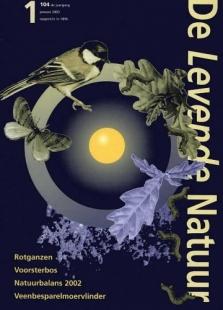De Levende Natuur nummer 1 van 2003 (English summary)
Afbeelding

Conservation of Boloria aquilonaris and its habitat
Wallis de Vries, M.F.
The Cranberry fritillary (Boloria aquilonaris) is a typical species of small raised bogs with mesotrophic influences. Its critically endangered status has prompted a species protection plan. This paper identifies its main habitat requirements as a sufficient area of peat bog, a high proportion of a micro-mosaic of mounds and depressions, a high-cover of mound species such as the host plant Oxycoccus palustris and Andromeda polifolia, an abundant nectar source of Erica tetralix and a low encroachment of grasses. A practical habitat quality index explained 79% of habitat occupancy. The main threats consist of desiccation, eutrophication, habitat fragmentation and ongoing succession. Solutions can be found in the creation of buffer zones between nature reserves and agricultural areas, restoration of degenerated bogs and small-scale peat cutting to set back succession. Conservation measures should be combined with adequate monitoring as a basis for adaptive management. It is argued that a species-based approach can be combined successfully with a system approach to achieve the conservation of entire ecosystems.
Colonization of the oldest wood in the youngest province Flevoland
Bremer, P.
The colonization of the Voorsterbos by wood-inhabiting plant species has been monitored and reviewed for a period of fifty years. The number of characteristic bryophytes stabilized after c. 25 years, while the number of vascular species will stabilize after c. 70 years. The colonization of `safe` sites will continue for a long time afterwards. For Ilex aquifolium e.g. the colonization of `safe` sites will continue for tens of years. 83 % of the established and potential wood-inhabiting species are growing within a distance of 10 kilometer from the area. At least twelve species came from an adjacent pleistocene area with a concentration of wood-inhabiting species. Other species came from human settlements (Ribes spp.) or were transported over larger distances (e.g. Circaea lutetiana). Anemochorous species are more succesfull in colonization than species with an epizoöchorous, endozoöchorous or short distance dispersal. But there are numerous species more succesfull than expected, e.g. Ceratocapnos claviculata and Milium effusum. The management of the area is focussed on the microclimate (light) in order to get a herb layer with characteristic species.
Geese between polder and salt marsh
Bakker, J.P., D. Bos, R.H. Drent & M.J.J.E. Loonen
Dark-bellied Brent geese Brenta bernicla bernicla breed in the Arctic. During winter and spring they stay in NW Europe before they leave for the breeding area in the second half of May. Initially they forage on fertilized pastures in polder areas, and stay when livestock grazing takes already place in early spring. When livestock grazing starts in May, the geese switch to adjacent salt marshes. With increasing levels of standing biomass due to primary production, the nutrient intake increases but declines again when levels of biomass become too high. This happens within a season due to declining forage quality caused by maturation, and to changes in sward structure: tillers become too long to be handled by the geese. Over the years, the geese are confronted with a decrease of palatable species due to ongoing succession on the salt marshes. Repeated removal of biomass by herbivores or farmers maintain the sward in a suitable stage, both within a season and over the years. By virtue to this facilitation Brent geese are enabled to utilize highly productive pastures until the end of their spring staging period and livestock-grazed salt marshes in spite of old marsh age. Disturbance of the geese strongly affects habitat use, especially because it allows the vegetation to 'escape' the grazing cycle and prevent it from losing its high quality. We hypothesize that the numbers of Brent geese in the entire Wadden Sea in May can be a factor four higher when all salt marshes are grazed by livestock, than in the absence of grazing.

